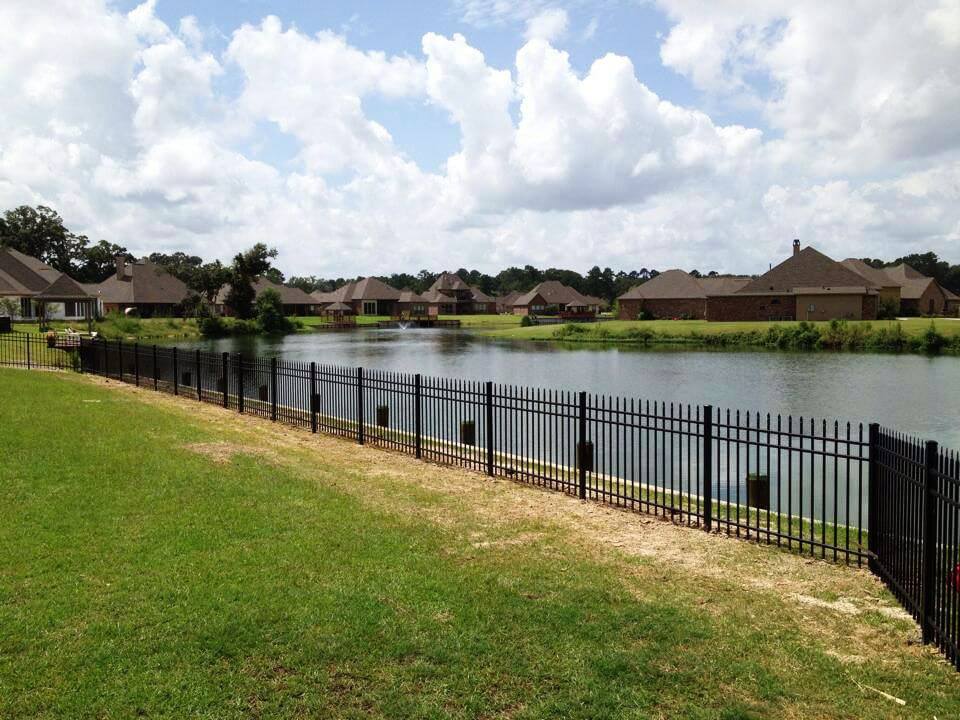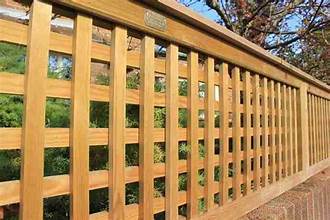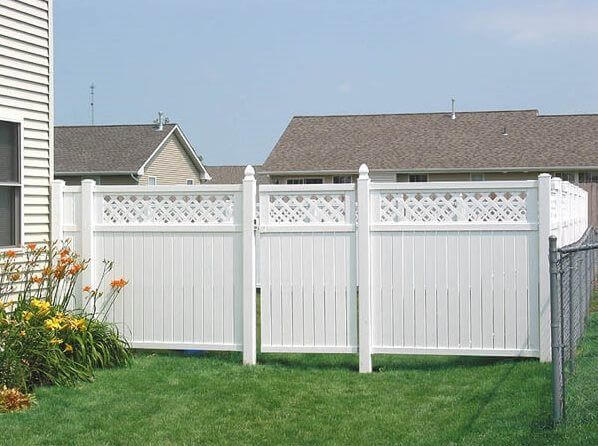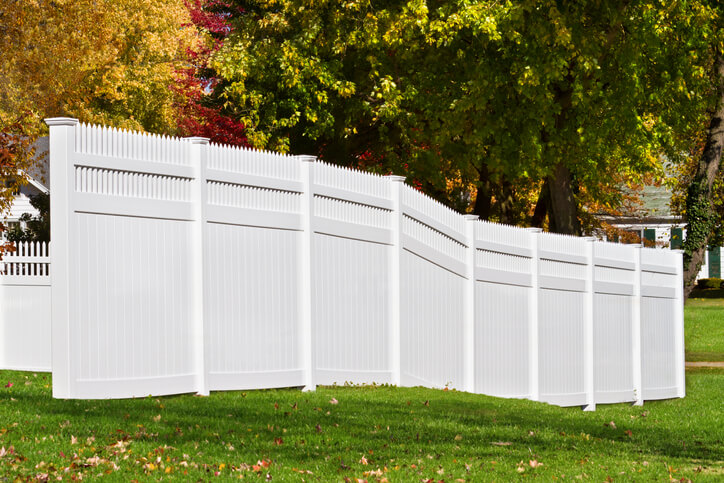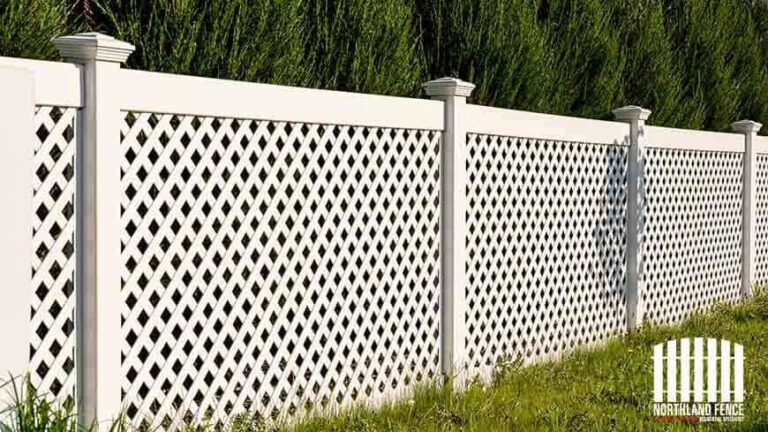Fencing plays a crucial role in safeguarding waterfront properties and enhancing their aesthetic appeal. Well-designed fencing provides security, and privacy, and helps to define boundaries in waterfront areas, while also adding visual interest and value to the property.
Waterfront properties are often sought after for their picturesque views and proximity to natural bodies of water.
Fencing serves as a protective barrier to prevent access to potentially hazardous water areas, such as pools, docks, or steep shorelines, thus ensuring safety for residents and visitors.
Furthermore, aesthetically pleasing fencing can complement the scenic waterfront surroundings, harmonizing with the natural landscape and adding to the overall charm of the property.
In this context, fencing is not only a utilitarian element but also an important design feature that contributes to the appeal and functionality of waterfront properties.

Factors To Consider For Waterfront Fencing
Choosing the right fencing for waterfront properties requires special considerations like corrosion resistance and minimal obstruction to views.
For expert advice and a selection of suitable options, Click here to get started.
This resource offers solutions tailored to the unique challenges of waterfront environments, ensuring both functionality and aesthetic appeal.
Property Layout And Size
The layout and size of the waterfront property are pivotal in determining the type of fencing that would be most suitable.
Consider the proximity to the water, the shape of the land, and any existing structures on the premises.
Additionally, assess the specific areas that require fencing, such as swimming pools, patios, or garden spaces, to ensure comprehensive coverage of the property.
Local Regulations And Permits
Prior to installing any fencing, it’s essential to research and adhere to the local regulations and obtain necessary permits.
Different locations have specific guidelines concerning waterfront development, which may include restrictions on the height, material, and proximity to the shoreline for fencing installations.
Failure to comply with these regulations could result in costly legal issues and setbacks.
Coastal Weather Conditions
The harsh coastal weather conditions can significantly impact the durability and maintenance requirements of waterfront fencing.
Factors such as saltwater exposure, high winds, and intense sun exposure can hasten the deterioration of certain materials.
Therefore, consider using weather-resistant materials such as aluminum, vinyl, or composite to ensure the longevity of the fencing.
Aesthetic And Functional Requirements
It’s important to balance both the aesthetic and functional aspects of waterfront fencing.
The fence should complement the natural beauty of the waterfront while also serving its practical purposes, such as providing a barrier for security and privacy.
Additionally, consider features like gates, lighting, and landscaping integration to enhance the overall appeal of the property.
Types Of Fencing Materials For Waterfront Properties
Waterfront properties offer stunning views and a serene environment, making them highly sought after.
When it comes to securing and enhancing the aesthetics of these properties, choosing the right fencing materials is crucial.
Let’s explore the various types of fencing materials commonly used for waterfront properties and dive into the benefits each material offers.
From wood to vinyl, aluminum to wrought iron, and composite, each material brings its own unique features to the table.
Wood
Wood fencing offers a classic, rustic charm that complements the natural beauty of waterfront surroundings.
Its aesthetic appeal and versatility make it a popular choice for homeowners looking to create a seamless blend with their surrounding landscape.
However, it requires regular maintenance to protect against moisture and decay, making it crucial for waterfront properties to use treated or naturally rot-resistant wood species such as cedar or redwood.
Vinyl
Vinyl fencing is a low-maintenance option that offers durability and resistance to rot, insects, and weathering.
It provides a clean and modern look, making it an ideal choice for waterfront properties seeking a sleek, uniform appearance.
The ease of maintenance and resistance to environmental factors make vinyl fencing a practical choice for waterfront settings.
Aluminum
Aluminum fencing combines durability and elegance, making it a popular choice for waterfront properties.
Its resistance to corrosion, low maintenance requirements, and unobstructed views of the water make it well-suited for properties seeking an unobtrusive yet effective fencing solution.
Plus, the availability of various styles and decorative options allows homeowners to customize their boundaries while maintaining an open and inviting atmosphere.
Wrought Iron
Wrought iron fencing exudes timeless charm and offers robust security for waterfront properties.
The enduring strength and distinctive appeal of wrought iron make it an excellent choice for properties seeking a blend of functionality and aesthetics.
While it may require periodic maintenance to prevent rusting, its longevity and sturdiness are valuable assets for waterfront security and visual appeal.
Composite
Composite fencing offers a blend of wood and plastic fibers, creating a material that mimics the look of wood while requiring minimal maintenance and offering excellent durability.
Its resistance to rot, decay, and insect damage makes it a practical choice for waterfront properties seeking the aesthetic appeal of wood without the associated maintenance concerns.
With a variety of color options available, composite fencing offers versatility while maintaining its appeal in waterfront settings.
Professional Installation Vs. Diy Approach
When it comes to enhancing the aesthetics and functionality of waterfront properties, the installation of fencing plays a crucial role.
Property owners often face the decision of whether to opt for professional installation services or tackle the project as a DIY endeavor.
Each approach comes with its own set of pros and cons, along with specific considerations for maintenance and environmental factors.
Understanding the nuances of professional installation versus the DIY approach is essential for making informed decisions regarding fencing for waterfront properties.
Pros And Cons Of Professional Installation
Professional installation of fencing for waterfront properties offers numerous advantages, including expertise in navigating the unique challenges posed by water-adjacent locations.
Furthermore, professional installers can provide warranty coverage and durable, long-lasting results.
However, it’s important to consider the higher costs associated with professional installation and the potential for scheduling delays depending on the availability of service providers.
Steps And Considerations For Diy Installation
Undertaking a DIY approach to installing fencing for waterfront properties allows property owners to save on labor costs and exercise creative freedom in the design and installation process.
However, adequate research and knowledge of local regulations and environmental considerations are essential.
Property owners should assess their level of expertise and the complexity of the project before deciding to pursue a DIY installation.
Regular Maintenance And Seasonal Checks
Regardless of the installation approach chosen, maintaining the fencing on waterfront properties is crucial for preserving its visual appeal and structural integrity.
Establishing a regular maintenance schedule, including seasonal checks for any signs of wear or damage, is imperative.
This proactive approach can help prevent the detrimental effects of saltwater corrosion and rust, which are common challenges in waterfront environments.
Addressing Saltwater Corrosion And Rust
Given the proximity to water, fencing in waterfront properties is particularly susceptible to saltwater corrosion and rust.
Property owners should prioritize the use of corrosion-resistant materials and apply protective coatings to mitigate these issues.
Additionally, conducting thorough inspections and addressing any signs of corrosion promptly can help prolong the lifespan of the fencing.
Landscaping Around The Fencing
Integrating landscaping elements around the fencing can further enhance the aesthetic appeal and functionality of waterfront properties.
Property owners should consider drought-resistant plants and sustainable landscaping practices that complement the fencing while withstanding the unique environmental conditions.
Strategic landscaping can also serve as a natural barrier against potential erosion, contributing to the overall resilience of the waterfront property.
Deterrent For Trespassers And Wildlife
Fencing play a crucial role in waterfront properties as a deterrent for both trespassers and wildlife.
It serves as a clear physical boundary, dissuading unauthorized access while ensuring the safety of inhabitants and maintaining ecological balance.
Illumination And Security Camera Integration
The integration of fencing with illumination and security camera systems further enhances its role as a deterrent.
By combining fencing with strategic lighting and surveillance technology, waterfront properties can significantly reduce the risk of trespassing and enhance security.
Privacy Enhancement In A Public Setting
Waterfront properties often blend the elements of private and public spaces, making privacy a key concern.
Fencing plays a crucial role in offering privacy to the inhabitants by demarcating their personal space from the public area, ensuring a peaceful and secluded environment.
Reducing Noise Pollution
Fencing also plays a significant role in reducing noise pollution in waterfront properties.
The natural barriers created by fencing help minimize the transmission of noise from surrounding areas, contributing to a more serene living environment.
Protection From Erosion And Flooding
In waterfront properties, protection from erosion and flooding is crucial for maintaining the integrity and value of the land.
Fencing around these properties plays a vital role in mitigating the effects of natural elements such as water, storms, and tides.
Let’s explore the impact of fencing on shoreline erosion, prevention of storm debris and high tides, preservation of vegetative buffer zones, and the influence on property resale value.
Impact Of Fencing On Shoreline Erosion
Fencing serves as a barrier against wave action, wind, and water flow that may contribute to shoreline erosion.
By strategically placing fencing, property owners can significantly reduce the impact of erosion, thus safeguarding their valuable waterfront land from gradual loss due to natural forces.
Preventing Storm Debris And High Tides
When storms bring high tides and debris, fencing acts as a protective shield, preventing the direct impact and accumulation of debris on the property.
This aids in minimizing the potential damage caused by storm surges and helps maintain the property’s structural integrity in the face of adverse weather events.
Preserving Vegetative Buffer Zones
Fencing plays a crucial role in preserving and delineating vegetative buffer zones along the shoreline.
These buffers are essential for stabilizing the soil, reducing sediment runoff, and providing habitat for wildlife.
Properly fenced areas can help maintain the ecological balance, contributing to the overall health of the waterfront environment.
Influencing Property Resale Value
The presence of well-designed and strategically placed fencing can have a positive impact on the resale value of waterfront properties.
Potential buyers value the added protection and aesthetic appeal that fencing provides, making it a desirable feature that can enhance the overall attractiveness and marketability of the property.

Frequently Asked Questions
What Fencing Options Work Best For Waterfront Properties?
Fencing options for waterfront properties must be durable and resistant to corrosion and saltwater damage.
How Does Fencing Enhance The Value Of Waterfront Properties?
Fencing not only provides security but also adds aesthetic appeal, increasing the overall value of waterfront properties.
Are There Specific Regulations For Fencing In Waterfront Areas?
Regulations regarding heights and materials for waterfront fencing may vary, so it’s essential to check local ordinances and guidelines.
Conclusion
To wrap up, incorporating fencing in waterfront properties not only enhances privacy and security but also adds aesthetic appeal and value.
With the right materials and design, fencing can make a significant difference in the overall functionality and overall look of a waterfront property.
Embracing the right fencing solution can truly maximize the potential of any waterfront property.

